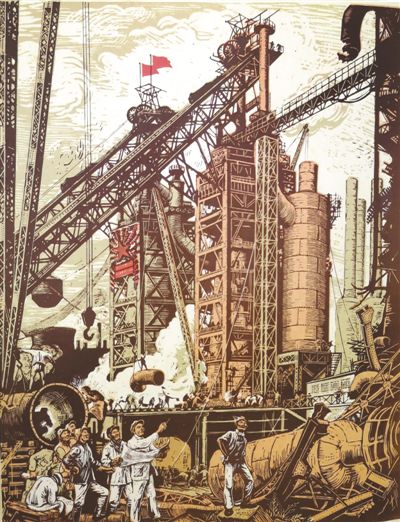China’s industrial art printing

“The Repair of the Ansteel Mills” (1949) by Gu Yuan Photo: FILE
As a special art form produced after the founding of the People’s Republic of China (PRC), industrial printed art has kept pace with China’s industrial development, epitomizing the process of China’s industrialization and providing fresh ideas and vitality to traditional Chinese printmaking. Over the last seven decades China has produced a great number of famous artists who have explored and pioneered different printing styles. Printed industrial art has made itself a unique visual culture in the history of global art as well as that of global industry.
Illustrations of industrialization
After the founding of the PRC, artists began to seek inspiration from contemporary society and depicted the vigorous development of China’s industry with the use of brushes and knifes. They recorded how the new China grew by employing new themes and various genres in their artworks.
Gu Yuan (1919–96) was a pioneer of printed industrial art. One of his prints in 1949, “The Repair of the Ansteel Mills,” illustrates a thriving steelmaker recovering from the rubble of decades of warfare and chaos in just a few years.
When it came to the 1950s, as the construction of new industrial buildings was in full swing across the country, industrial art printmaking began to focus on industrial projects and tried to portray the remarkable progress that had been made by China’s modern industry at the time. Many outstanding artworks, such as “Foziling Reservoir Under Construction” by Chen Yanqiao and “The Last Girder” by Wu Shi, depict compelling and energetic scenes where workers strive to build China into an industrial power. During the 1960s and 1970s, artworks that highlighted the spirits of the industrial workforce sprang up, such as “A Female Machinist” by Xu Fubao, “Source of Power” by Zhao Zongzao and “Steel Workers” by Yan Han. These prints portrayed the great diligence and vitality of the working class during that period. To some extent, the printmaking of industrial art developed hand in hand with China’s construction of socialism.
Influenced by these professional print artists, some workers across the country who were also art lovers engaged in industrial art printmaking. In October 1959, the first group of printmakers specialized in industrial art, known as Yi Ye, was formed in the Wuhan Iron and Steel Group (a Chinese state-owned enterprise that started to operate in 1958 in Wuhan, Hubei Province). Soon, similar groups emerged one after another from where major industries were located, such as Dalian in Liaoning Province, Daqing in Heilongjiang Province and Tanggu District of the Tianjin municipality. They used prints as a vehicle to show who they were and what they were fighting for. The printmaking of industrial art reached its peak after it was no longer limited to only artists, but also available as a cultural activity of the common people.
Diversity
After the reform and opening up, the rapid advancement and achievements of urbanization became the primary focus of the printmaking of industrial art. Meanwhile, they were blended with elements of modern aesthetics, thus forming diverse styles.
In the 1980s, the collective art creation of industrial prints made great progress. In 1983, a quarterly named Ban Hua Shi Jie (World of Prints, literally) began to be issued by People’s Fine Arts Publishing House. This quarterly focused on the printmaking created by the groups of workers. They collaborated with 71 groups of workers across the country. A large number of industrial art prints were published in this quarterly. During the middle and late 1980s, the groups of printmakers from Yi Ye, Daqing, Dagang, Tanggu, Dalian and Zhanjiang were famous at home and abroad for their achievements with art prints.
After the establishment of the research institute of China’s industrial art printmaking in 1991, industrial art printmaking flourished with various exhibitions and related activities. Related theories were also developed. Since then, the groups of printmakers have been reorganized across the country and built into different institutes of industrial art prints. These efforts greatly strengthened the creation and research of industrial art printmaking.
As the aesthetics of art advanced, the perception of industrial art printing gradually changed. In addition to the realism style, the printmakers paid more attention to absorbing the essence of Western art and traditional art. They tried to make their artworks more aesthetically appealing. China witnessed a high yield in the printmaking of this art form at that time. Artworks including “Manufacturing a Great Ship” by Zhang Jiarui and “Builders” by Yan Jun were known for their beautiful composition, while “Flying Over Time and Space” by Li Jianping and “Song of Shenzhen” by Luo Wenguan were rich in symbolic meaning; “Game” by Wang Yonghui and “Love” by Wang Song absorbed the elements of the brick reliefs of the Han Dynasty to achieve a unique style.
Innovation
In recent years, prints of industrial art have been frequently honored with awards in national exhibitions and have shown up in international art exhibitions and cultural activities, earning worldwide respect and admiration.
The new era endows industrial art printmaking with new characteristics. A large number of prints depict the scenes of new industries in China, such as digitalized manufacturing, the industrial internet and mechanical intelligence, which reflect the renewed vigor of the new era. Meanwhile, more innovative techniques and materials are employed in printmaking. Some printmakers use symbols and metaphor in their works to display their concerns about a deeper relationship between the industry development, humans and the environment during industrialization and social transformation in modern times.
In the past seven decades, prints of industrial art, which displayed the charm of traditional Chinese prints and people’s endeavors in the pursuits of their dreams and glory, became a remarkable form in the field of Chinese fine arts.
The article was edited and translated from People’s Daily. Li Yunjing is a research fellow form Beijing Luxun Museum.
edited by REN GUANHONG

 PRINT
PRINT CLOSE
CLOSE